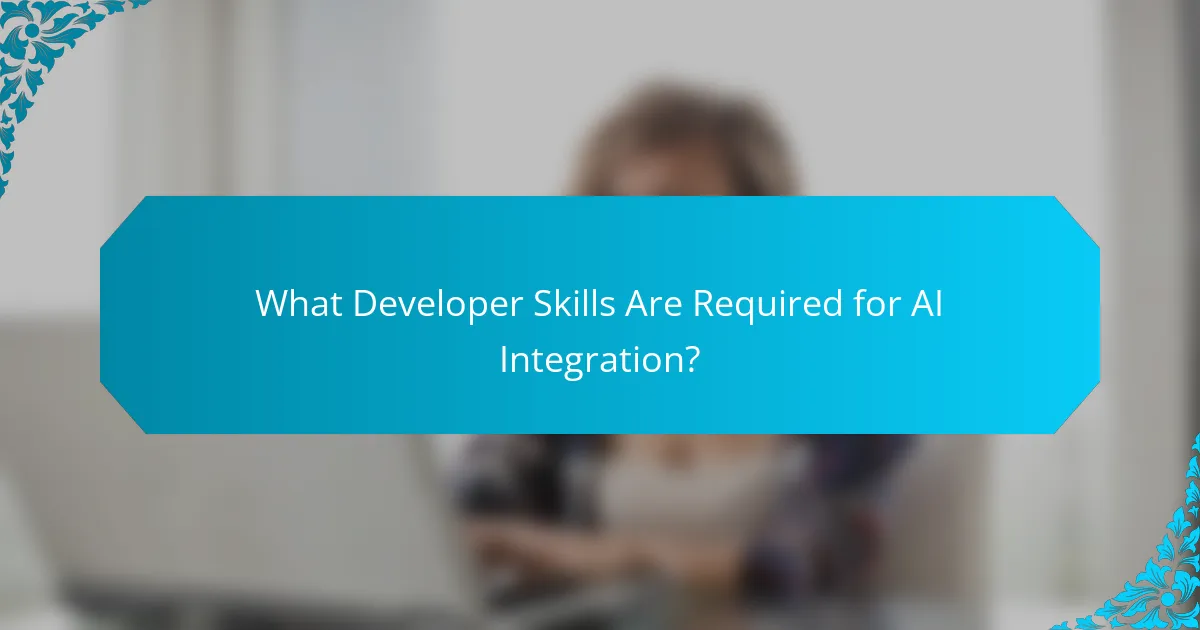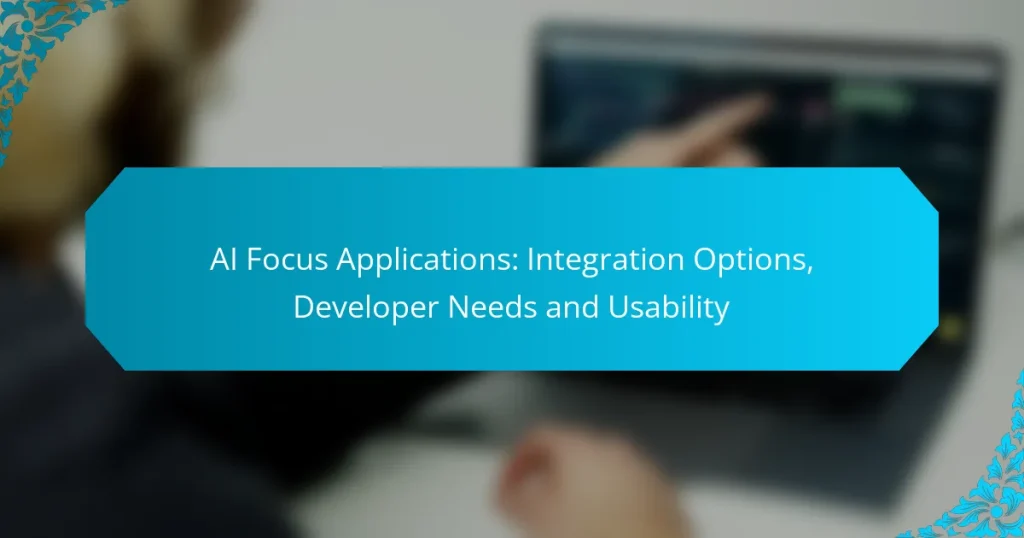AI focus applications, such as Natural Language Processing and Predictive Analytics, offer transformative integration options that enhance operational efficiency and decision-making across industries. Selecting the right integration strategy requires a careful assessment of business objectives, technical capabilities, and budget considerations. Developers must possess a diverse skill set, including machine learning expertise and API experience, to successfully implement and optimize these AI solutions.

What Are the Best AI Focus Applications for Integration?
The best AI focus applications for integration include Natural Language Processing, Computer Vision, Predictive Analytics, Robotic Process Automation, and Recommendation Systems. These technologies enhance efficiency, improve decision-making, and provide personalized experiences across various industries.
Natural Language Processing
Natural Language Processing (NLP) enables machines to understand and interpret human language. It is essential for applications like chatbots, sentiment analysis, and language translation. When integrating NLP, consider the quality of the training data and the specific use case to ensure accuracy and relevance.
Common tools for NLP integration include libraries like NLTK and spaCy, which provide pre-built models and functionalities. It’s crucial to evaluate the performance of these tools based on your specific requirements, such as processing speed and language support.
Computer Vision
Computer Vision allows machines to interpret and process visual information from the world. This technology is widely used in facial recognition, object detection, and image classification. When integrating computer vision, assess the hardware requirements and the complexity of the algorithms to ensure optimal performance.
Popular frameworks for computer vision include OpenCV and TensorFlow. Consider the trade-offs between accuracy and processing time, especially in real-time applications, to achieve the desired outcomes.
Predictive Analytics
Predictive Analytics uses historical data to forecast future outcomes, making it valuable for businesses in decision-making processes. This application is often used in finance, marketing, and supply chain management. When integrating predictive analytics, focus on the quality of data and the algorithms used for modeling.
Tools like R and Python libraries such as scikit-learn can facilitate predictive modeling. It’s important to regularly update models with new data to maintain accuracy and relevance in predictions.
Robotic Process Automation
Robotic Process Automation (RPA) automates repetitive tasks, improving efficiency and reducing human error. This technology is particularly useful in finance, HR, and customer service. When integrating RPA, identify processes that are rule-based and high-volume to maximize benefits.
Popular RPA tools include UiPath and Automation Anywhere. Ensure proper change management practices are in place to support employees during the transition to automated processes.
Recommendation Systems
Recommendation Systems analyze user behavior to suggest products or services, enhancing customer experience and increasing sales. These systems are commonly used in e-commerce and streaming services. When integrating recommendation systems, consider the algorithms that best fit your data and user preferences.
Collaborative filtering and content-based filtering are two common approaches. Regularly evaluate the system’s performance and user satisfaction to refine recommendations and improve engagement.

How to Choose the Right Integration Options?
Choosing the right integration options involves aligning your business objectives with the technical capabilities of AI applications. Consider factors such as your specific needs, existing infrastructure, and budget constraints to make an informed decision.
Assessing Business Needs
Start by identifying the core objectives of your AI integration. Determine whether you aim to enhance customer service, streamline operations, or improve data analysis. This clarity will guide your selection of integration options that best support these goals.
Engage stakeholders from various departments to gather insights on their requirements. This collaborative approach ensures that the chosen integration aligns with the broader business strategy and addresses the needs of all users.
Evaluating Technical Compatibility
Assess the existing technology stack to ensure compatibility with potential AI solutions. Consider factors such as software architecture, data formats, and APIs. A seamless integration minimizes disruptions and enhances overall efficiency.
Conduct a technical review to identify any gaps that may require additional resources or modifications. For instance, if your current systems are primarily cloud-based, prioritize AI solutions that offer robust cloud integration capabilities.
Cost-Benefit Analysis
Perform a cost-benefit analysis to weigh the financial implications of different integration options. Consider not only the initial investment but also ongoing maintenance costs and potential savings from improved efficiency.
Use a simple framework to evaluate costs against expected benefits. For example, if an integration option costs USD 10,000 but is projected to save USD 5,000 annually, calculate the return on investment over a few years to determine its viability.

What Developer Skills Are Required for AI Integration?
Developers looking to integrate AI into applications need a blend of technical skills, including proficiency in machine learning, experience with APIs, and knowledge of data management. These competencies ensure that AI solutions are effectively implemented and optimized for performance.
Proficiency in Machine Learning
Proficiency in machine learning is crucial for developers working on AI integration. This includes understanding algorithms, model training, and evaluation techniques. Familiarity with popular frameworks like TensorFlow or PyTorch can significantly enhance a developer’s ability to create effective AI models.
Developers should focus on grasping concepts such as supervised and unsupervised learning, as well as reinforcement learning. Practical experience with datasets and the ability to preprocess data are also essential skills that contribute to successful AI integration.
Experience with APIs
Experience with APIs is vital for integrating AI functionalities into applications. Developers should be comfortable using RESTful APIs to connect AI services with their applications, allowing for seamless data exchange and functionality. Understanding how to authenticate and manage API requests is equally important.
Familiarity with tools like Postman can help developers test and debug API interactions efficiently. Additionally, knowledge of API documentation and versioning practices ensures that integrations remain stable and maintainable over time.
Knowledge of Data Management
Knowledge of data management is essential for developers involved in AI integration, as data quality directly impacts AI performance. Developers should understand how to store, retrieve, and manipulate data effectively, utilizing databases like SQL or NoSQL systems depending on the application needs.
It’s important to implement data governance practices to ensure compliance with regulations such as GDPR or CCPA, especially when handling sensitive information. Developers should also consider data security measures to protect user data throughout the integration process.

What Are the Usability Considerations for AI Applications?
Usability considerations for AI applications focus on how effectively users can interact with the technology. Key aspects include user interface design, accessibility features, and performance metrics, all of which significantly impact user experience and satisfaction.
User Interface Design
User interface design is crucial for ensuring that AI applications are intuitive and user-friendly. A well-designed interface should prioritize clarity, allowing users to navigate easily and understand the AI’s functionalities. Consider using familiar design patterns and visual cues to guide users through complex tasks.
Incorporating feedback mechanisms, such as tooltips and confirmation messages, can enhance user confidence. Regular usability testing with real users can help identify pain points and improve the overall design.
Accessibility Features
Accessibility features are essential for making AI applications usable for individuals with disabilities. This includes support for screen readers, keyboard navigation, and customizable text sizes. Ensuring compliance with standards like the Web Content Accessibility Guidelines (WCAG) can help create a more inclusive experience.
Consider implementing voice commands and alternative input methods to cater to a wider audience. Regular audits and user feedback can help identify areas for improvement in accessibility.
Performance Metrics
Performance metrics are vital for assessing the effectiveness and efficiency of AI applications. Key metrics include response time, accuracy, and user satisfaction ratings. Aim for low response times, ideally in the low tens of milliseconds, to ensure a seamless user experience.
Regularly monitoring these metrics can help identify issues and areas for optimization. User surveys and analytics can provide valuable insights into how well the application meets user needs and expectations.

What Are the Local Trends in AI Integration?
Local trends in AI integration focus on enhancing efficiency and productivity across various sectors. Companies are increasingly adopting AI technologies to streamline operations, improve customer experiences, and drive innovation.
Industry-Specific Applications in North America
In North America, industries such as healthcare, finance, and retail are leading the way in AI integration. For instance, healthcare providers utilize AI for predictive analytics to enhance patient care and streamline administrative tasks. In finance, AI algorithms help in fraud detection and risk assessment, while retailers leverage AI for personalized marketing and inventory management.
These applications often require tailored solutions that address specific industry challenges. Businesses should consider the unique needs of their sector when implementing AI technologies to ensure optimal results.
Regional Regulatory Compliance
Compliance with regional regulations is crucial for successful AI integration in North America. Organizations must navigate laws related to data privacy, such as the General Data Protection Regulation (GDPR) in Canada and various state-specific regulations in the U.S. Understanding these legal frameworks helps mitigate risks associated with data handling and AI deployment.
To ensure compliance, companies should conduct regular audits of their AI systems and data practices. Establishing clear policies and training staff on regulatory requirements can help prevent potential legal issues and foster trust with customers.


